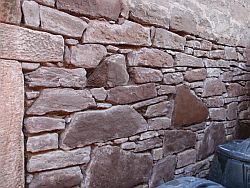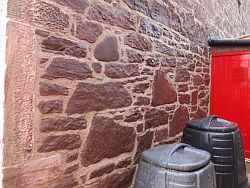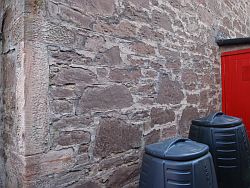|
Why use lime mortar? Natural Limestone based mortars, plaster and harling were used in the construction of many pre-1914 Scottish building and boundary walls. Since then, most repair work has used cement or concrete based materials. However, this can cause damage to the building stone, and retain water in the building, because the lime mortared joints are covered with a hard impermeable layer, which does not allow moisture to escape. Also, lime mortar is more flexible because it is softer, and hairline cracks can repair themselves, whilst cement mortars crack and fall off the wall. The photographs show a wall with cracked cement covering the joints on the left, in need of repointing. The old cement is removed, and the joints cleaned back to the original lime mortar, usually a depth of 25mm. The fresh lime mortar is then put in, beaten to force it into the joints and cured for 7-10 days under damp hessian sheeting in order for it to harden. The mortar continues to absorb moisture and carbon dioxide for two years after the sheeting is removed, which gradually cures it to its full hardness. Properly cured lime mortar will last at least 50 years before repointing, and because the mortar used must be softer than the stone in the building, it is designed to fail before moisture and frost damage those stones. Two of the stones in the centre of the picture have been repaired using a colour-matched lime based repair mortar. | ||
|
|
 |
 |
|
Home | Dry Stone Walls and Features| Lime Mortar | Why Use Lime Mortar? | Price Guide | ||
